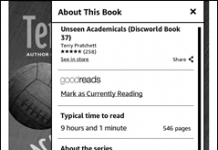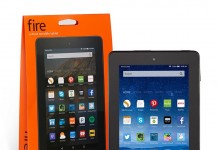Important news. Mobi, which is what Kindle uses now, is a pretty limited format, but HTML 5 opens up the world to the Kindle. Here’s the announcement from their Kindle Format 8 page.
Announcing HTML5 Support
in Kindle Format 8 |
 |
 CSS3 support CSS3 support |
 Floating elements Floating elements |
 Fixed layouts Fixed layouts |
 Text on background images Text on background images |
 Embedded fonts Embedded fonts |
 Numbered and bulleted lists Numbered and bulleted lists |
 Drop caps Drop caps |
And many more! |
|
| We’re pleased to announce a wide range of new features and enhancements – including HTML5 support – coming in Kindle Format 8 (KF8). KF8 is the next generation file format for Kindle books – replacing Mobi 7. As showcased on Kindle Fire, KF8 enables publishers to create great-looking books in categories that require rich formatting and design such as children’s picture books, comics & graphic novels, technical & engineering books and cookbooks. Kindle Format 8 replaces the Mobi format and adds over 150 new formatting capabilities, including fixed layouts, nested tables, callouts, sidebars and Scalable Vector Graphics, opening up more opportunities to create Kindle books that readers will love. |
| Children’s books |
 |
| Children’s picture books come to life with brilliant images, fixed layouts and Kindle Text Pop Up. |
|
| Comics and graphic novels |
 |
| Comics and graphic novels are presented in high resolution color with Kindle Panel Views. |
|
| Technical and engineering |
 |
| Technical and engineering books are created more efficiently with Cascading Style Sheet 3 formatting, nested tables, boxed elements and Scalable Vector Graphics. |
|
| Cookbooks |
 |
| Cookbooks and other titles requiring rich design look spectacular with embedded fonts, callouts and sidebars, drop caps and text on background images. |
|
| The list of new capabilities in Kindle Format 8 can be found here. |
| Upcoming enhancements to Kindle Publisher Tools will make it easier and faster for publishers to create high quality Kindle books. KindleGen 2 (available soon) creates Kindle content from a wide variety of sources including HTML, XHTML, and EPUB. Kindle Previewer 2 (available soon) provides an easy way for publishers to preview how titles will look on Kindle devices and apps so they can be confident that their Kindle books look great. |
Related







































And now we have to wait for someone to crack the new DRM.
Are they bothering with new DRM? They were already embedding EPUBs inside DRM-protected Mobis, so you’d think that’s how the backwards-compatibility is going to work.
Never mind the plumbing (wrappers, drm, file structure); in the real world, people don’t buy tech (or specs, standards, or formats) they buy solutions, tools, content.
And *that* is the only thing that matters: whatever added value the new format enables for consumers, what new markets it open up to the ebook evolution.
The KF8 page at Amazon points out some interesting possibilities:
– textbooks and academic papers
– interactive children’s books and training manuals
– native-format comics structured around “Kindle panels” (whatever that may be. 😉 Reflowable comics? Guided-view?)
– native-format fixed-page layouts
– embedded fonts and drop-caps, etc, for those that want to tart-up ebooks to replicate print editions
– pretty much everything epub3 is supposed to do (it might even be epub3 in disguise :))
The existing mobi format has proven itself sufficient for narrative text ebooks that constitute Amazon’s stock in trade and the bulk of their catalog. It was also enough to take ebooks from a techie niche to a mainstream consumer product.
KF8 looks to extend the Kindle focus to Academia, education, comics, and possibly even the corporate markets. Plus do a much better job at newspapers and magazines. These are all places where epub3 should be useful and where it might have been a competitive weapon for competitors. (Amazon just defanged that threat, no?)
I don’t think the timing of this announcement is an accident: shortly after epub3 is finalized but before any consumer-level implementation (gadget or app) is announced, much less delivered. This is simply a preemptive strike at the epub3 hype to come, probably from Apple (the most likely to be first to deploy) as well as a notice to publishers that yes, it is safe to invest in rich content ebooks because by the time the books reach market there will be millions of Kindle readers, tablets, and apps ready for them.
The significance of the latter cannot be understated. Every K4, Fire, (and possibly K3) will be a target for HTML5 ebooks. By January, that will be a minimum of 10 million if published reports are to be believed. (5 million Fires, up to 6 million K4s.) And then there’s the apps…
Which is to say: this is good for *everybody*, not just Kindle users.
Whine all you want about Amazon’s go-it-alone approach if that is your mission in life, but Amazon has just settled the chicken and egg question for the next phase of the ebook evolution and greased the skids for epub3 (and equivalents) to be commercially viable at least one year sooner than without them.
That this puts their competitors under the gun to rush their deployment of epub3 and forces them to promise to upgrade their current models is just a bit of frosting on the cake. Any competitor without an epub3 (or equivalent) solution in place by spring is going to be at a serious marketting disadvantage.
Mike Shatzkin been pointing out that ebook penetration is uneven; some categories have zero ebook market share while others run north of 50%. A levelling off might have been expected soon if something didn’t happen to open up more categories to ebooks. Which is now happening. Comics, textbooks, magazines, interactive manuals, possibly even corporate presentations can now migrate from apps to portable, native format ebooks.
The publishing industry just got another boost into the 21st century, earlier than desired, no doubt. Expect further disruptions and major growth in color/interactive content.
The fun is just starting.
It will be interesting to see a code-level comparison and contrast between this and EPUB v3. Already we know that KF8 doesn’t support audio and video. That seems like a mistake to me.
Folks, this is still all running on a 7″ screen. That’s still not big enough for most of the areas they’re trying to enter. Children’s books, textbooks, and newspapers on that small a screen? Give me a break!
If anything, this is going to handicap designers for years, because they’ll have to design for such a small screen as a lowest common denominator. Thanks a bunch, Amazon!
i want technical books (indian university) i.e. R.S.Khurmi, R.K.Bansal, P.K.Nag in kindle 8 formatt soooon……………………..